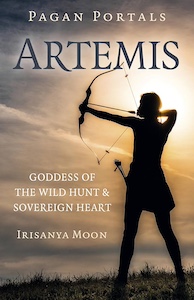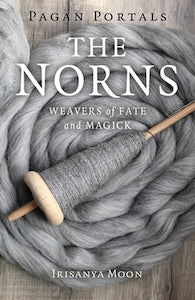
Pagan Portals – Artemis: Goddess of the Wild Hunt & Sovereign Heart, by Irisanya Moon
Moon Books, 1803413212, 112 pages, March 2024
I have been lacking a clear direction lately. Seeking clarity, I did a meditation for guidance, during which I felt a call to get to know the goddess Artemis. Intrigued by her lore and the promise of empowerment she symbolizes, I turned to Pagan Portals – Artemis: Goddess of the Wild Hunt & Sovereign Heart by Irisanya Moon in hopes of learning more about how to connect with Artemis in order to discern where to point my own bow and arrow. This book promised not just background knowledge, but an introduction to a path that could potentially align me with the strength and independence epitomized by Artemis herself.
“I believe Artemis is being called into these times, like a friend and trusted ally. She can call us back to the wild hunt and claim our sovereignty (the ability to self-govern and be self-possessed). Artemis is not one of just play and delight, though She is that too, She is a being of action and alignment. She knows Her values and acts on them.”1
Moon is a seasoned Pagan Portals author whose previous titles covered Aphrodite, Iris, The Norns, Gaia, and the Reclaiming witchcraft tradition. In this book, she turns her attention towards the goddess Artemis, teaching readers Her family lineage, stories, myths, symbols, and offerings, as well as guidance on how to create and sustain a relationship with Her.
What I appreciate about Moon’s approach to Artemis is that she leaves a lot of room open for readers to cultivate their own relationship. She does not present herself as the end-all-be-all authority on Her; rather she comes across as someone who sincerely wishes to share what she has learned through her own journey alongside historical sources to reveal the many facets of this goddess. She shares references, quotes other sources, and provides a detailed bibliography at the end for readers to use as a springboard for their own research.
What Moon does do that aids readers, especially those new to working with Artemis, is call upon her experience as a witch, priestess, and teacher to guide readers in opening the pathway to cultivate a relationship with Artemis and embark on a journey of self-empowerment along the way. For instance, Moon begins the book by assuring readers there’s no right or wrong way to proceed, and that the most important thing is to cultivate self-trust. She writes:
“When you trust yourself, you build a relationship that can face all that the wild has to teach you. There is no time in the hunt to go back and forth about every decision. Claim yourself as the wise one you need when it is time to aim.”2
This was just the advice I needed to hear to get me in the right frame of mind to more deeply connect with Artemis, as well as understand on a more personal level what I had been lacking recently–determination, focus, and confidence in my vision. Moon then offers a meditation to meet Artemis in the forest to begin the journey. This is the first of many “magickal practices” that are offered at the end of each chapter for the readers to perform.
Moon’s coverage of Artemis’s birth and family helped me to situate her within my knowledge of Greek mythology. It also introduced me to new goddesses, such as Diktyanna and Eileithya, who Artemis has been linked with at times. Reading direct translation of her mythology (Hymn 3 to Artemis by Callimachus) gave me insight into her personality as someone who knows what they want from life and has the courage to ask for it directly, once again a trait that could use some cultivation in myself.
The many ways Aretmis shows up are described by Moon–nature, the moon, protection, hunting and wild beasts, maidens, sacrifice, and Amazons–painted a well-round picture. Artemis is simultaneously a provider of life and death, birthing and killing, healing and sacrificing all simultaneously. The mythological stories of Artemis further illuminate the wrath of her punishment when transgressed alongside the blessings bestowed to those devoted to her.
Chapters covering Artemis’s symbols and offerings, devotional practices, and cultivating a relationship with the wild and Artemis are perfect for beginners to become acquainted. Moon encourages readers to reflect on what they can give to Artemis beyond the traditional offerings too, suggesting readers provide service and action towards what is important to Her (nature, protecting women) to facilitate a relationship. As Goddess of the Hunt, action is important to building the trust of Artemis for those who wish to be devoted to Her for any length of time.
The chapter on devotional practices goes into detail about cults of Artemis and festivals held in Her honor. Moon also offers chants and epithets too. I particularly liked the magickal practice for this chapter where Moon leads readers through envisioning Artemis in the hunt and then moving their own bodies in the same way, infusing the wild energy in one’s own limbs.
“She knows what it takes to come back into your being. To come back to the wild from which you have been born and created and made. To come back to the sacred hunt that needs you and knows you.”3
For those ready to formalize their relationship with Artemis, Moon shares a full dedication ritual. Meanwhile, she also gives plenty of practical advice for working with a deity, Artemis in particular, for those who are new to it in their spiritual practice. Moon explains how having patience, sitting with one’s fears, and embracing the unknown, are important for readers as they cultivate their connection to Artemis. Once again, Moon’s comforting wisdom comes across as caring and friendly, lacking any hint of pretension or judgment. It’s clear Moon’s aim is to guide readers towards trusting their own instincts as a pathway to better relate to Artemis.
Overall, Pagan Portals – Artemis: Goddess of the Wild Hunt & Sovereign Heart takes readers on a journey toward fostering a spiritual connection with the goddess Artemis by traversing ancient myths, embracing the wilderness within and without, and seeking the empowerment that comes from aligning with her fierce independence and nurturing care. Moon guides readers to not only discover Artemis in the world around us but also find pieces of Her within themselves too, recognizing our strength, our capacity for growth, and our intrinsic value as protectors of the natural world and each other.
Readers who are ready to step into the role of the hunter, listen to the wisdom of the forest, attune to the cyclic rhythm of the moon, and turn their hearts to the wild will highly enjoy getting to know the untamed spirit of Artemis through Moon’s thoughtful writing. Since finishing this book, I’ve noticed my self-trust has grown, and I am feeling more confident stating my own needs. I do feel like Artemis’s energy comes through quite well in this book, and I hope other readers find it as empowering too! In Artemis, we find not just a deity to admire, but a reflection of our deepest, most powerful selves, calling us to live with authenticity, courage, and compassion in every aspect of our lives.
Alanna Kali is an astrologer, numerologist, and pioneer spirit that loves to explore life through the lens of depth psychology. She has a passion for studying the humanities and social trends. Her academic work is centered upon reuniting body, mind, and spirit through eco-psychology. She loves reading, spending time in nature, and travel.







